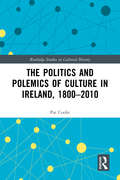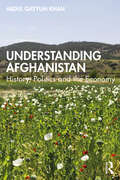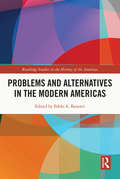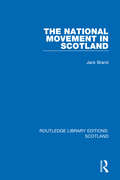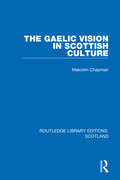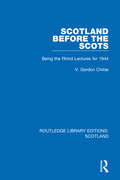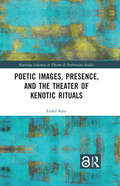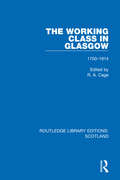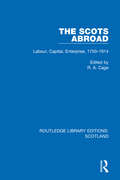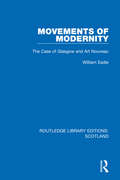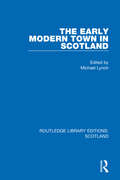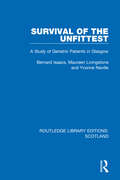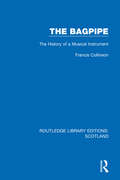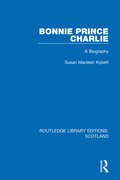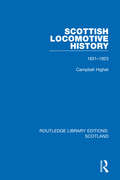- Table View
- List View
The Politics and Polemics of Culture in Ireland, 1800–2010 (Routledge Studies in Cultural History #112)
by Pat CookeAs a contribution to cultural policy studies, this book offers a uniquely detailed and comprehensive account of the historical evolution of cultural policies and their contestation within a single democratic polity, while treating these developments comparatively against the backdrop of contemporaneous influences and developments internationally. It traces the climate of debate, policies and institutional arrangements arising from the state’s regulation and administration of culture in Ireland from 1800 to 2010. It traces the influence of precedent and practice developed under British rule in the nineteenth century on government in the 26-county Free State established in 1922 (subsequently declared the Republic of Ireland in 1949). It demonstrates the enduring influence of the liberal principle of minimal intervention in cultural life on the approach of successive Irish governments to the formulation of cultural policy, right up to the 1970s. From 1973 onwards, however, the state began to take a more interventionist and welfarist approach to culture. This was marked by increasing professionalization of the arts and heritage, and a decline in state support for amateur and voluntary cultural bodies. That the state had a more expansive role to play in regulating and funding culture became a norm of cultural discourse.
Understanding Afghanistan: History, Politics and the Economy
by Abdul QayyumThis book delves into the history of Afghanistan, its people, and its relationship with neighbours, to unravel the intricate politics and ethnolinguistic diversity of the country. It discusses the history of innumerable invasions which left imprints over the country and its people and (have) created a complex fabric of different ethnic, linguistic, religious and cultural groups. The volume looks at the various empires which warred over the land including the Persian, Greek, Mongol, and Sassanid dynasties as well as the later interferences by the British and the Russians and the emergence of the Taliban. It examines the correlations between war, power politics, religion, local governance, and the opium trade and economy in Afghanistan. The author through personal stories and anecdotes of his visits and journeys in Afghanistan provides a very rich and extensive view of Afghan politics, culture and history. The relationship between Afghanistan and Pakistan and Afghanistan’s unique position in the politics of the region is also a thread which runs through the entire book. This book will a great resource (be of interest) to researchers and students of politics, history, Central and South Asian Studies, war and international relations, political economy, and peace and reconciliation studies. It will also interest journalists, diplomats and international development organizations.
Problems and Alternatives in the Modern Americas
by Pablo A. BaisottiThis volume explores several notable themes related to political processes in Latin America and offers insightful historical perspectives to understand national, regional, and global issues in the continent from the beginning of the 20th century to the present day. The collected essays focus on Latin American politics such as: political cycles, left-wing political parties, nationalism, progressivism, crime and resistance, violence, authoritarianism, and relationships with the United States, Venezuela, Chile, Ecuador, Brazil, Colombia, and Paraguay. The perspectives of the chapters presented an attempt to seek lines of continuity by highlighting traditional interpretations of new scenarios and refusing to impose a traditional and uncritical linear historical narrative. The fundamental objective of the volume is to provide a rational and critical political-historical explanation of Latin America since the early 20th century with the purpose, among others, of deepening understanding of the present.
Understanding Afghanistan: History, Politics and the Economy
by Abdul QayyumThis book delves into the history of Afghanistan, its people, and its relationship with neighbours, to unravel the intricate politics and ethnolinguistic diversity of the country. It discusses the history of innumerable invasions which left imprints over the country and its people and (have) created a complex fabric of different ethnic, linguistic, religious and cultural groups. The volume looks at the various empires which warred over the land including the Persian, Greek, Mongol, and Sassanid dynasties as well as the later interferences by the British and the Russians and the emergence of the Taliban. It examines the correlations between war, power politics, religion, local governance, and the opium trade and economy in Afghanistan. The author through personal stories and anecdotes of his visits and journeys in Afghanistan provides a very rich and extensive view of Afghan politics, culture and history. The relationship between Afghanistan and Pakistan and Afghanistan’s unique position in the politics of the region is also a thread which runs through the entire book. This book will a great resource (be of interest) to researchers and students of politics, history, Central and South Asian Studies, war and international relations, political economy, and peace and reconciliation studies. It will also interest journalists, diplomats and international development organizations.
The Politics and Polemics of Culture in Ireland, 1800–2010 (Routledge Studies in Cultural History #112)
by Pat CookeAs a contribution to cultural policy studies, this book offers a uniquely detailed and comprehensive account of the historical evolution of cultural policies and their contestation within a single democratic polity, while treating these developments comparatively against the backdrop of contemporaneous influences and developments internationally. It traces the climate of debate, policies and institutional arrangements arising from the state’s regulation and administration of culture in Ireland from 1800 to 2010. It traces the influence of precedent and practice developed under British rule in the nineteenth century on government in the 26-county Free State established in 1922 (subsequently declared the Republic of Ireland in 1949). It demonstrates the enduring influence of the liberal principle of minimal intervention in cultural life on the approach of successive Irish governments to the formulation of cultural policy, right up to the 1970s. From 1973 onwards, however, the state began to take a more interventionist and welfarist approach to culture. This was marked by increasing professionalization of the arts and heritage, and a decline in state support for amateur and voluntary cultural bodies. That the state had a more expansive role to play in regulating and funding culture became a norm of cultural discourse.
The National Movement in Scotland (Routledge Library Editions: Scotland #2)
by Jack BrandOriginally published in 1978, but now re-issued with a new Preface by James Mitchell, this volume traces the rise of the SNP, with special emphasis on explaining the increase of the National Party vote in Scotland from the early 1960s to the late 1970s. The book draws much of its information from interviews with members and ex-members of the SNP, including some who helped to found the party in 1928. In describing the movement and giving an account of its main features, the author begins with a discussion of various aspects of Scottish society which have contributed to the growth of nationalism. These include the political developments of the Labour movement, the economic history of 20th Century Scotland the development of youth culture and in particular, the interest in folk music, as well as developments in the Church, the army, and the press.
The Gaelic Vision in Scottish Culture (Routledge Library Editions: Scotland #5)
by Malcolm ChapmanOriginally published in 1978, this book explores the relationship between the Gaelic and English spheres of life, from the life of the bilingual Gael, in the confrontation of Highland and Lowland Scotland and the literary expressions of these. It is argued that the picture of Gaelic society that is popularly accepted does not owe its form to any simple observation, but to symbolic and metaphorical requirements imposed by the larger society. Beginning with the birth of the Romantic movement and moving on to modern Gaelic literature and anthropological studies, aspects of the relationship of a dominant to a ‘minority’ culture are raised. The racial stereotypes of Celt and Anglo-Saxon that were widely accepted in the 19th Century are also discussed, and the understanding of how a dominant intellectual world has used Gaelic society in the process of seeking its own definition is pursued through a study of the concepts of ‘folklore’ and the ‘folk’.
The Gaelic Vision in Scottish Culture (Routledge Library Editions: Scotland #5)
by Malcolm ChapmanOriginally published in 1978, this book explores the relationship between the Gaelic and English spheres of life, from the life of the bilingual Gael, in the confrontation of Highland and Lowland Scotland and the literary expressions of these. It is argued that the picture of Gaelic society that is popularly accepted does not owe its form to any simple observation, but to symbolic and metaphorical requirements imposed by the larger society. Beginning with the birth of the Romantic movement and moving on to modern Gaelic literature and anthropological studies, aspects of the relationship of a dominant to a ‘minority’ culture are raised. The racial stereotypes of Celt and Anglo-Saxon that were widely accepted in the 19th Century are also discussed, and the understanding of how a dominant intellectual world has used Gaelic society in the process of seeking its own definition is pursued through a study of the concepts of ‘folklore’ and the ‘folk’.
Scotland Before the Scots: Being the Rhind Lectures for 1944 (Routledge Library Editions: Scotland #6)
by V. Gordon ChildeOriginally published in 1946, this book presents in what can arguably be described as an unusual way, a slice of Scottish social life by applying to prehistory the principles of Marxism as practised by Soviet scholars of Russian prehistory. Using archaeological evidence, the author distinguishes 6 stages – from the earliest definable groups of immigrants to the Iron Age. There are 10 appendices, devoted to the typology and classification of tombs, pottery, implements and fortifications.
The National Movement in Scotland (Routledge Library Editions: Scotland #2)
by Jack BrandOriginally published in 1978, but now re-issued with a new Preface by James Mitchell, this volume traces the rise of the SNP, with special emphasis on explaining the increase of the National Party vote in Scotland from the early 1960s to the late 1970s. The book draws much of its information from interviews with members and ex-members of the SNP, including some who helped to found the party in 1928. In describing the movement and giving an account of its main features, the author begins with a discussion of various aspects of Scottish society which have contributed to the growth of nationalism. These include the political developments of the Labour movement, the economic history of 20th Century Scotland the development of youth culture and in particular, the interest in folk music, as well as developments in the Church, the army, and the press.
Poetic Images, Presence, and the Theater of Kenotic Rituals (Routledge Advances in Theatre & Performance Studies)
by Eniko SepsiThis book explores the interrelation of contemporary French theatre and poetry. Using the pictorial turn in the various branches of art and science, its observable features, and the theoretical framework of the conceptual metaphor, this study seeks to gather together the divergent manners in which French poetry and theatre address this turn. Poetry in space and theatricality of poetry are studied alongside theatre, especially to the performative aspect of the originally theological concept of "kenosis". In doing so the author attempts to make use of the theological concept of kenosis, of central importance in Novarina’s oeuvre, for theatrical and dramatological purposes. Within poetic rituals, kenotic rituals are also examined in the book in a few theatrical practices – János Pilinszky and Robert Wilson, Jerzy Grotowski and Eugenio Barba – facilitating a better understanding of Novarina’s works. Accompanied by new English translations in the appendices, this is the first English language monograph related to the French essayist, dramaturg and director Valère Novarina’s theatre, and will be of great interest to students and scholars in theatre and literature studies.
The Working Class in Glasgow: 1750-1914 (Routledge Library Editions: Scotland #4)
by R. A. CageOriginally published in 1987, this book examines how much industrialisation improved the standard of living of the British worker, based on the experience of one representative city: Glasgow. It analyses whether there was an increase in skilled as opposed to unskilled labour in major industrial centres – as for example in Glasgow, manufacturing shifted from textiles to engineering. Other important issues such as the rate of housing construction, public health, local politics and leisure pursuits are also considered. Glasgow has a long history of working-class culture and is therefore a particularly interesting city to study.
The Scots Abroad: Labour, Capital, Enterprise, 1750-1914 (Routledge Library Editions: Scotland #3)
by R. A CageOriginally published in 1985, this book examines the extent of Scottish migration and Scottish involvement in the process of development. Although there are many books written on the Scots abroad, this volume is unique in that it has a unifying theme: each contributor has concentrated on the role played by the Scots in the economic development of their relevant country or area which include England, Canada, the USA, Australia, New Zealand, India, Latin America and Japan. This will be of interest to both social and economic historians.
The Working Class in Glasgow: 1750-1914 (Routledge Library Editions: Scotland #4)
by R. A CageOriginally published in 1987, this book examines how much industrialisation improved the standard of living of the British worker, based on the experience of one representative city: Glasgow. It analyses whether there was an increase in skilled as opposed to unskilled labour in major industrial centres – as for example in Glasgow, manufacturing shifted from textiles to engineering. Other important issues such as the rate of housing construction, public health, local politics and leisure pursuits are also considered. Glasgow has a long history of working-class culture and is therefore a particularly interesting city to study.
The Scots Abroad: Labour, Capital, Enterprise, 1750-1914 (Routledge Library Editions: Scotland #3)
by R. A. CageOriginally published in 1985, this book examines the extent of Scottish migration and Scottish involvement in the process of development. Although there are many books written on the Scots abroad, this volume is unique in that it has a unifying theme: each contributor has concentrated on the role played by the Scots in the economic development of their relevant country or area which include England, Canada, the USA, Australia, New Zealand, India, Latin America and Japan. This will be of interest to both social and economic historians.
Scotland Before the Scots: Being the Rhind Lectures for 1944 (Routledge Library Editions: Scotland #6)
by V. Gordon ChildeOriginally published in 1946, this book presents in what can arguably be described as an unusual way, a slice of Scottish social life by applying to prehistory the principles of Marxism as practised by Soviet scholars of Russian prehistory. Using archaeological evidence, the author distinguishes 6 stages – from the earliest definable groups of immigrants to the Iron Age. There are 10 appendices, devoted to the typology and classification of tombs, pottery, implements and fortifications.
Movements of Modernity: The Case of Glasgow and Art Nouveau (Routledge Library Editions: Scotland #11)
by William EadieOriginally published in 1990, acknowledges the social as well as the artistic significance of the Glasgow Art Nouveau movement by examining the history of it from its inception through to its demise. By considering the contributions of social theorists like Peter Bürger, Theodor Adorno, and Walter Benjamin, the author illustrates how Art nouveau can be located within an avant-garde. The book also reveals to what extent the contract which the Glasgow group had with the Secessionists in Vienna was significant for the development of their work.
The Early Modern Town in Scotland (Routledge Library Editions: Scotland #16)
by Michael LynchOriginally published in 1987, this volume filled a notable gap in Scottish urban history and considers the place of Scottish towns in urban life during the 16th and 17th Centuries. The first part of the book is based on studies of individual burghs (Aberdeen, Dundee, Edinburgh and Perth) drawing extensively on archival material. The second part includes a discussion of the pressure put upon the burghs by the town between 1500 and 1650, a process which contributed to the destruction of the medieval burgh and examines the burgh during the Scottish Revolution. The impact of war and plague on Scottish towns in the 1640s is also analysed and much emphasis is given to the relationship between town and country.
Survival of the Unfittest: A Study of Geriatric Patients in Glasgow (Routledge Library Editions: Scotland #13)
by Bernard Isaacs Maureen Livingstone Yvonne NevilleOriginally published in 1972, this book is an analytical account of the socio-medical tribulations suffered by Glasgow’s east-end elderly leading to referral to geriatric wards. It examines why so many old people suffer from physical, mental and social deprivation in the final years of their lives. It shows by statistical studies and illustrative case histories that the basic cause is the survival into old age of people who are unfit to care for themselves, in such numbers that help from families, neighbours, the social services and the NHS is insufficient. From this study the expression the "geriatric giants" or the four I’s was coined: impairment of intellect (cerebral dysfunction), incontinence, immobility and instability (falls). The term ‘giant’ is seen to refer both to statistical frequency and to the huge personal burden of sufferers, escalating the need for socio-medical intervention. Prophetic in its predictions that the huge and complex social care problem would grow in the future much of this book remains relevant today.
The Bagpipe: The History of a Musical Instrument (Routledge Library Editions: Scotland #9)
by Francis CollinsonOriginally published in 1975, and written by an authority on Scottish music, this book traces the evolution of the bagpipe whilst also narrating the fortunes of the ‘Great Highland Bagpipe’ itself. Exploring history and archaeology of civilizations as far removed from the Scottish Highlands as Egypt and Mesopotamia, Greece and Rome this book offers a unique full-length history of one of the world’s most interesting and ancient musical instruments. Appendices list the bagpipes of other countries and the materials used in the instrument’s manufacture as well as a comprehensive bibliography.
The Early Modern Town in Scotland (Routledge Library Editions: Scotland #16)
by Michael LynchOriginally published in 1987, this volume filled a notable gap in Scottish urban history and considers the place of Scottish towns in urban life during the 16th and 17th Centuries. The first part of the book is based on studies of individual burghs (Aberdeen, Dundee, Edinburgh and Perth) drawing extensively on archival material. The second part includes a discussion of the pressure put upon the burghs by the town between 1500 and 1650, a process which contributed to the destruction of the medieval burgh and examines the burgh during the Scottish Revolution. The impact of war and plague on Scottish towns in the 1640s is also analysed and much emphasis is given to the relationship between town and country.
Bonnie Prince Charlie: A Biography (Routledge Library Editions: Scotland #14)
by Susan Maclean KybettOriginally published in 1988, this biography was the result of 15 years research, including unearthing 70,000 letters and documents among the Stuart Papers which had hitherto lain largely untapped. Written in many different languages, some were damaged, written in code, or unsigned and undated. Deciphering them therefore made it possible to gain a new level of insight into Bonnie Prince Charlie as a man, his relationship with his exiled father, the role played by France and the true nature of the events leading up to the bloody campaign of 1745 in which he attempted to win back the throne of his ancestors.
Scottish Locomotive History: 1831-1923 (Routledge Library Editions: Scotland #12)
by Campbell HighetOriginally published in 1970, this volume is a valuable source of extensive data concerning Scotland’s railways and locomotives. Material that has appeared in books, technical journals, society and institutional proceedings is here gathered together, enabling the reader to easily trace details of design and construction on the five main railways of Scotland from 1831 until 1923 when all the railways in Britain came together under English control. As well as being of interest to engineers, this volume will also appeal to railway and social historians.
The Bagpipe: The History of a Musical Instrument (Routledge Library Editions: Scotland #9)
by Francis CollinsonOriginally published in 1975, and written by an authority on Scottish music, this book traces the evolution of the bagpipe whilst also narrating the fortunes of the ‘Great Highland Bagpipe’ itself. Exploring history and archaeology of civilizations as far removed from the Scottish Highlands as Egypt and Mesopotamia, Greece and Rome this book offers a unique full-length history of one of the world’s most interesting and ancient musical instruments. Appendices list the bagpipes of other countries and the materials used in the instrument’s manufacture as well as a comprehensive bibliography.
Bonnie Prince Charlie: A Biography (Routledge Library Editions: Scotland #14)
by Susan Maclean KybettOriginally published in 1988, this biography was the result of 15 years research, including unearthing 70,000 letters and documents among the Stuart Papers which had hitherto lain largely untapped. Written in many different languages, some were damaged, written in code, or unsigned and undated. Deciphering them therefore made it possible to gain a new level of insight into Bonnie Prince Charlie as a man, his relationship with his exiled father, the role played by France and the true nature of the events leading up to the bloody campaign of 1745 in which he attempted to win back the throne of his ancestors.
